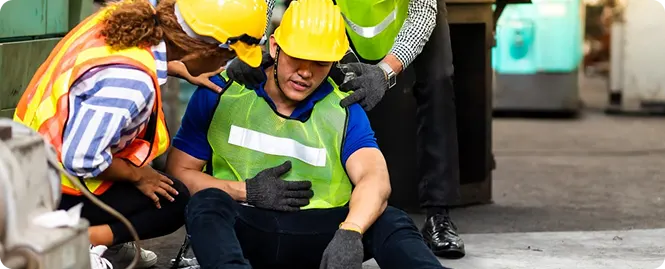Common Risks Faced by Convenience Stores
Table of Contents
Key Takeaways
-
A convenience store can feel like a magnet for "five-finger discounts," but strong security measures, well-placed cameras, and risk management strategies can help keep inventory losses in check. Don’t let unnoticed shrinkage eat into your profits!
-
From sudden natural disasters to unexpected “artwork” on your storefront, property damage can hit hard. Commercial property insurance ensures that whether it’s a storm or a spray can, your business can bounce back without breaking the bank.
-
Accidents happen—spills, slips, and mishaps in high-traffic areas can lead to more than just a bruised ego. Workplace safety should be a top priority, and having general liability insurance can protect against the unexpected, including potential bodily injury claims.
-
From faulty wiring to unattended equipment, fire risks lurk in every corner. Regular safety checks and insurance coverage can ensure that a minor issue doesn’t turn into a major loss. A little prevention goes a long way in keeping your convenience store safe.
-
Hackers love a good challenge, and cash registers and credit card systems make tempting targets. Cybersecurity risks are just as real as physical threats, so protecting customer data is key. A good insurance agent can help safeguard against financial losses from breaches.
Running a convenience store isn’t just about stocking shelves—it’s about staying prepared for the unexpected. Store owners face unique challenges daily, from theft and vandalism to natural disasters and cybersecurity risks. Even minor incidents can lead to property damage, lost income, or legal trouble without proper risk management. Understanding the common dangers in convenience stores allows store owners to take proactive steps, ensuring their business stays safe, profitable, and fully ready for whatever comes next.
A well-planned risk management strategy is the key to long-term success. Strong security measures, general liability insurance, and business interruption insurance protect against financial setbacks caused by bodily injury, fires, or even cybersecurity threats. Investing in insurance coverage and safety protocols helps convenience store operators minimize risks while maintaining smooth operations. With the proper protections in place, convenience store owners can put their focus on growing their business instead of worrying about any unexpected disruptions.
Theft and Robbery
Convenience stores face significant risks of theft and robberies. Externally, these stores are frequent targets for armed robberies due to their extended hours and cash-based transactions. Internally, employee theft can also pose a substantial threat, with staff potentially misappropriating cash or merchandise. For instance, in Grovetown, Georgia, a Kroger front-end manager was arrested for allegedly stealing $44,000 from the store's self-checkout registers over four months, highlighting the vulnerability of such establishments to internal theft.
The inherent characteristics of convenience stores make them a prime target for criminal activities. Having late operating hours and the necessity of cash handling further increases their exposure to theft and robbery. In Chicago, two convenience stores were robbed within a 30-minute span; in one incident, the clerk was pepper-sprayed before the assailants stole merchandise and cash. Such incidents emphasize the importance of convenience store owners implementing robust security measures to mitigate these growing risks.

Vandalism and Property Damage
Property damage and vandalism are significant concerns when it comes to convenience stores, especially in high-crime areas. These incidents can include graffiti, smashed windows, or even break-ins, leading to extensive destruction. Some criminals use ram-raiding, where vehicles crash into storefronts to gain entry. In Windsor Locks, Connecticut, thieves used a tow hook and cable to steal an ATM, causing severe structural damage. Such acts not only lead to financial loss but also compromise store security.
These damages disrupt the store operations, which force temporary closures and costly repairs. Business owners face significant losses from stolen merchandise and increased security expenses. Additionally, visible vandalism can drive away customers, damaging the store’s overall reputation. For instance, in California, three 7-Eleven stores were ransacked all within just 20 minutes, with thieves assaulting an employee in the process and stealing merchandise. Such incidents erode customer trust and cause a drastic impact on business sales.

Workplace Injuries and Employee Safety
Convenience store employees are prone to facing frequent workplace injuries such as slips, trips, and falls. Wet floors, cluttered aisles, and uneven surfaces contribute to these accidents. Lifting heavy stock improperly can lead to strains and sprains, while prolonged standing may cause musculoskeletal issues. Additionally, being exposed to robberies or violent altercations poses a risk of serious injury. In 2018, slips, trips, and falls accounted for more than 30,000 injuries in the retail sector.
Maintaining rigorous safety standards works as a crucial element to protect both employees and customers in convenience stores. Business owners can significantly reduce the risk of accidents by implementing proper housekeeping practices, such as promptly cleaning spills and keeping walkways clear. Regular safety audits help identify potential hazards before they can cause any harm. Engaging frontline employees in these assessments ensures a comprehensive understanding of types of workplace dangers, fostering a safer environment for all.

Shoplifting and Inventory Loss
Shoplifting has a direct effect on convenience stores by reducing the overall inventory and cutting into profit margins. According to the National Retail Federation, retail shrinkage—mostly from theft—cost U.S. retailers $94.5 billion in 2021—frequent shoplifting forces stores to raise prices, discouraging customers and lowering overall sales. High-theft locations report up to a 12% annual decline in profit margins. For example, rampant retail theft in San Francisco forced multiple Walgreens locations to close overnight.
Convenience stores can minimize theft by strengthening security and training staff to detect suspicious behavior. You can deter shoplifters by installing high-quality surveillance cameras, anti-theft signage, and electronic article surveillance (EAS) tags. Staff vigilance also plays a crucial role in maintaining safety—employees trained to recognize theft patterns and engage customers reduce losses. The Laurel Ace Hardware in Oakland cut shoplifting in half using AI-powered surveillance. Proactive theft prevention helps protect profits and ensure safer shopping.

Fire Hazards
Convenience stores are likely to face significant fire risks and hazards due to a myriad of factors. For example, malfunctioning electrical equipment, such as frayed cords or overloaded circuits, can ignite fires if not looked after. Cooking areas, especially those with grease buildup, can pose additional hazards. For instance, cooking equipment fires cost a company over $5.4 million in a three-year period. Additionally, having improper storage of flammable materials can further exacerbate fire risks.
Implementing stringent fire prevention strategies is absolutely crucial when running a convenience store. Regular inspections of electrical systems can help identify and rectify hazards such as damaged wiring. Maintaining cleanliness in cooking areas, mainly by preventing grease accumulation, reduces fire potential. For example, fire hazards can be mitigated effectively by installing and maintaining kitchen fire suppression systems. Equipping stores with appropriate fire suppression systems and ensuring staff are trained in emergency protocols further enhances safety.

Health and Safety Concerns
Convenience stores selling perishable goods face significant food safety, hygiene, and sanitation risks. Improper storage temperatures can lead to bacterial growth, increasing the risk of foodborne illnesses. Cross-contamination is more likely to happen when raw and cooked foods are inadequately separated. For instance, a McDonald's E. coli outbreak linked to undercooked beef patties resulted in 49 cases and one death. Additionally, inadequate cleaning practices can attract pests, further compromising the overall safety of food.
Adhering to health inspections and complying with local regulations are vital for ensuring food safety in convenience stores. Regular inspections help identify potential hazards, such as improper food storage or sanitation issues, allowing for timely corrective actions. For example, the FDA mandates the use and testing of sanitizer solutions in food preparation areas to prevent contamination. Compliance with guidelines set by authorities, like the Food and Drug Administration (FDA), ensures that establishments maintain high standards.

Natural Disasters and Weather Risks
Extreme weather events such as hurricanes can severely disrupt convenience store operations in the United States. These natural disasters often lead to risks like property damage, inventory loss, and forced closures, resulting in significant financial setbacks. For example, during Hurricane Milton in 2024, major retailers like Publix and Walmart closed numerous stores across Florida to ensure safety. Such closures can cause a halt in sales and impact supply chains, limiting customer access to essential goods.
To minimize the impact of extreme weather, convenience stores should implement comprehensive preparedness and mitigation strategies. This includes developing detailed evacuation plans, securing backup power sources, and conducting regular structural assessments to ensure building integrity. Maintaining clear communication channels with staff and customers is also crucial. For example, to avoid more risks, Walmart employs an in-house meteorologist to provide timely weather updates, enabling proactive measures to safeguard operations and community well-being if there is a hurricane.

Cybersecurity and Data Breaches
Convenience stores processing digital payments face significant risks of cyberattacks and data breaches. Hackers often target point-of-sale (POS) systems, self-checkout kiosks, and mobile payment platforms to steal sensitive customer information. For example, in 2019, Wawa suffered a massive data breach when malware infiltrated its payment processing servers, compromising millions of customers' credit and debit card details. This breach led to lawsuits and reputational damage. Cybercriminals continue to exploit weak security systems, making data protection crucial.
Securing customer data and payment systems is essential to prevent breaches and financial fraud. Convenience store operators should implement advanced encryption, multi-factor authentication, and firewalls to protect transaction data. Regular system updates, employee cybersecurity training, and compliance with the Payment Card Industry Data Security Standard (PCI DSS) can significantly reduce risks. Companies like Target strengthened their security measures after a major breach in 2013, reinforcing the importance of proactive protection and ensuring implementation of safety protocols.

Conclusion
Running a convenience store isn’t just about stocking shelves but tackling risks head-on. Owners face countless challenges, from theft and vandalism to workplace injuries, fire hazards, and even cyber threats. Strong risk management strategies, like security systems, employee training, and compliance measures, help minimize these dangers and keep operations smooth.
That’s where insurance steps in as a safety net. An insurance policy protects against property damage, bodily injuries, theft, and cyber threats, ensuring financial security when things go south. Whether it’s general liability, commercial property, or business interruption coverage, the right plan keeps convenience stores thriving and their customers returning.

